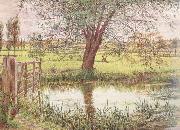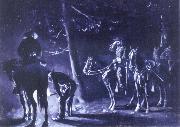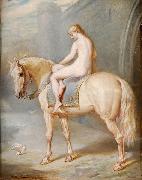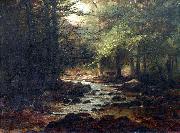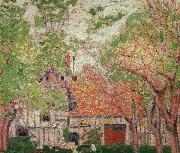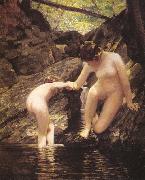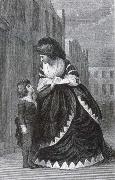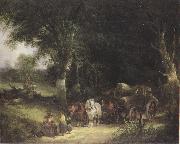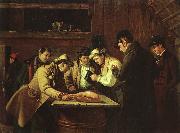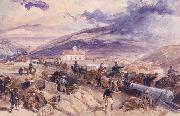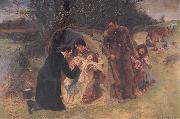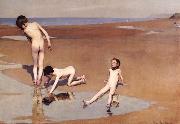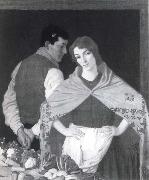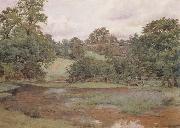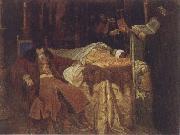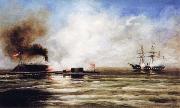|
|
|
|
|
|
|
|
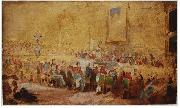 |
William Salter
|
|
painted Sketch of the 1836 Waterloo Banqet by William Salter in 1836 |
|
|
|
|
|
|
|
 |
William Scrots
|
|
William (or Guillim) Scrots (or Scrotes or Stretes) (active 1537-1553) was a painter of the Tudor court and an exponent of the Mannerist style of painting in the Netherlands. He is first heard of when appointed a court painter to Mary of Habsburg, Regent of the Netherlands, in 1537. In England, he followed Hans Holbein as King's Painter to Henry VIII in 1546, with a substantial annual salary of £62 10s, over twice as much as Holbein's thirty pounds a year. He continued in this role during the reign of the boy king Edward VI. His salary was stopped on Edward's death in 1553, after which it is not known what became of him, though it is presumed he left England.
Edward VI, attributed to Scrots, Hampton Court.
Portrait of Edward VI in distorted perspective, 1546.Little more is known of Scrots than that his paintings showed an interest in ingenious techniques and detailed accessories. Scrots was paid 50 marks in 1551 for three "great tables", two of which were portraits of Edward delivered to the ambassadors Thomas Hoby and John Mason as gifts for foreign monarchs, and the third a "picture of the late earle of Surrey attainted." Two full-length portraits of Edward VI in a pose similar to that of Holbein's portrait of his father, one now in the Royal Collection (left) and another now in the Louvre (below), are attributed to Scrots and are likely to be these two paintings. Scrots also painted an anamorphic profile of Edward VI, distorted so that it is impossible to view it normally except from a special angle to the side. This optical trick is similar to that used by Holbein in his painting The Ambassadors and in contemporary portraits of Francis I and Ferdinand I. Later, when the painting was exhibited at Whitehall Palace in the winter of 1591-92, it created a sensation, and important visitors were all taken to see it. |
|
|
|
 |
william shakespeare
|
|
Born: 23 April 1564
Birthplace: Stratford-upon-Avon, England
Died: 23 April 1616
Best Known As: The famed author of Romeo and Juliet |
|
|
|
|
|
|
|
|
|
|
|
|
|
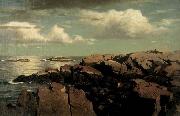 |
William Stanley Haseltine
|
|
(June 11, 1835-February 3, 1900) was an American painter and draftsman who was associated with the Hudson River School and Luminism.
Born in Philadelphia to John Haseltine, a successful businessman, and Elizabeth Shinn Haseltine, an amateur landscape painter, Haseltine studied at the University of Pennsylvania and then at Harvard University, where he received a degree in 1854.
He first exhibited his paintings the following year at the Pennsylvania Academy of Fine Arts, after which he sailed to Europe, first joining a colony of American painters who were studying in Dusseldorf, then traveling up the Rhine into Switzerland and Italy. In late 1857 he settled in Rome, and in the following months made numerous excursions to draw the landscape around Rome and on Capri.
In 1858 Haseltine returned to Philadelphia, and by late 1859 was installed in the Tenth Street Studio Building in New York City, then a central point for American landscape painters; also in the building were Frederic Edwin Church, Albert Bierstadt, and Worthington Whittredge, the latter two having befriended Haseltine in Europe. Though many of his paintings from this time derived from his European sketches, Haseltine also began to paint the oceanside of New England, especially favoring the rockbound coasts of Narragansett, Rhode Island, Nahant, Massachusetts, and Mount Desert Island, Maine. The precision with which he painted these landscapes won critical praise, and Haseltine was elected an Associate of the National Academy of Design in 1860, and a full Academician in 1861.
In 1864 Haseltine's wife died in childbirth. He spent some time training his nephew, Howard Russell Butler, but he moved after he married Helen Marshall in 1866. Initially the family considered settling in Paris, but in 1867 they moved to Rome, which would for most of Haseltine's subsequent years serve as his home and point of departure from which to produce views of the European landscape. While his paintings of Capri and Sicily would prove popular with visiting American tourists, Haseltine also traveled and drew in France, Holland, Belgium, and the Netherlands, summering in Bavaria and the Tyrol in the 1880s and 1890s. In his later years he also returned periodically to the United States, making a final trip to the west in 1899.
Haseltine died of pneumonia in Rome in 1900. |
|
|
|
|
|
|
|
|
|
|
|
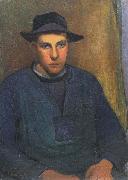 |
Wladyslaw slewinski
|
|
(1854-1918) was a Polish painter. He was a student of Gauguin's and a leading artist of the Young Poland movement.
Władysław Ślewiski was a Polish painter. He administered his estate in Poland before traveling to Paris in 1888. Once there he studied at the Academie Colarossi where he met Gauguin. The impression this encounter made on him and Gauguin's encouragement prompted Slewinski to dedicate himself to art. He submitted to Gauguin's artistic and personal influence, spending time with him in Paris and, from 1889, in Pont-Aven and Le Pouldu in Brittany.
Seascapes painted during this period include Cliffs in Brittany. In 1891 Gauguin painted a portrait of Slewinski and presented it to him. During this period Slewinski exhibited in Paris, with some success, both at the Salon des Independents in 1895 and 1896 and the Galerie Georges Thomas in 1897 and 1898.
|
|
 |
Wojciech Stattler
|
|
(1800, Krakew - 1875) was a Polish painter of Swiss aristocratic ancestry and a long-standing professor of the School of Fine Arts in Krakew.
|
|
|
|
|







